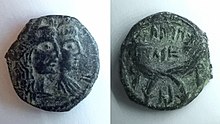
Back Nabatese alfabet Afrikaans أبجدية نبطية Arabic নবতীয় লিপি Bengali/Bangla Lizherenneg nabateek Breton Alfabet nabateu Catalan Nabatäische Schrift German Alfabeto nabateo Spanish الفبای نبطی Persian Alphabet nabatéen French Nabateus ábécé Hungarian
| Nabataean script | |
|---|---|
| Script type | |
Time period | 2nd century BC to 4th century AD |
| Direction | Right-to-left script |
| Languages | Nabataean Aramaic Nabataean Arabic |
| Related scripts | |
Parent systems | |
Child systems | Arabic script |
| ISO 15924 | |
| ISO 15924 | Nbat (159), Nabataean |
| Unicode | |
Unicode alias | Nabataean |
| U+10880–U+108AF Final Accepted Script Proposal | |
| History of the alphabet | ||
|---|---|---|
|
||
|
||

The Nabataean script is an abjad (consonantal alphabet) that was used to write Nabataean Aramaic and Nabataean Arabic from the second century BC onwards.[2][3] Important inscriptions are found in Petra (now in Jordan), the Sinai Peninsula (now part of Egypt), and other archaeological sites including Abdah (in Israel) and Mada'in Saleh in Saudi Arabia.
Nabataean is only known through inscriptions and, more recently, a small number of papyri.[4] It was first deciphered in 1840 by Eduard Friedrich Ferdinand Beer.[4] 6,000 – 7,000 Nabataean inscriptions have been published, of which more than 95% are extremely short inscriptions or graffiti, and the vast majority are undated, post-Nabataean or from outside the core Nabataean territory.[4] A majority of inscriptions considered Nabataean were found in Sinai,[4] and another 4,000 – 7,000 such Sinaitic inscriptions remain unpublished.[5] Prior to the publication of Nabataean papyri, the only substantial corpus of detailed Nabataean text were the 38 funerary inscriptions from Hegra (Mada'in Salih), published by Julius Euting in 1885.[4]

- ^ Himelfarb, Elizabeth J. "First Alphabet Found in Egypt", Archaeology 53, Issue 1 (Jan./Feb. 2000): 21.
- ^ Everson, Michael (2010-12-09). "N3969: Proposal for encoding the Nabataean script in the SMP of the UCS" (PDF). Working Group Document, ISO/IEC JTC1/SC2/WG2.
- ^ Omniglot.
- ^ a b c d e Healey, John F. (2011). "On Stone and Papyrus: reflections on Nabataean epigraphy". Palestine Exploration Quarterly. 143 (3). Informa UK Limited: 163–165. doi:10.1179/003103211x13092562976054. ISSN 0031-0328. S2CID 162206051.
Sinai, for example, is a major source of Nabataean inscriptions: the corpus of M. E. Stone contains 3,851 Nabataean items! But most were written by individuals who had no connection with Nabataea itself during the period of the Nabataean kingdom or its immediate aftermath and they may not normally have spoken Aramaic. The texts have generally been thought to have been written long after Nabataea as such disappeared.
- ^ Larison, Kristine M. (2020). ""Prolific Writing": Retracing a Desert Palimpsest in the South Sinai". In A. Hoffmann (ed.). Exodus: Border Crossings in Jewish, Christian and Islamic Texts and Images. Judaism, Christianity, and Islam – Tension, Transmission, Transformation. De Gruyter. pp. 77–92. doi:10.1515/9783110618549-005. ISBN 978-3-11-061854-9. S2CID 214051677.
- ^ Yaʻaḳov Meshorer, "Nabataean coins", Ahva Co-op Press, 1975; 114.
- ^ https://en.numista.com/catalogue/pieces69784.html Numista